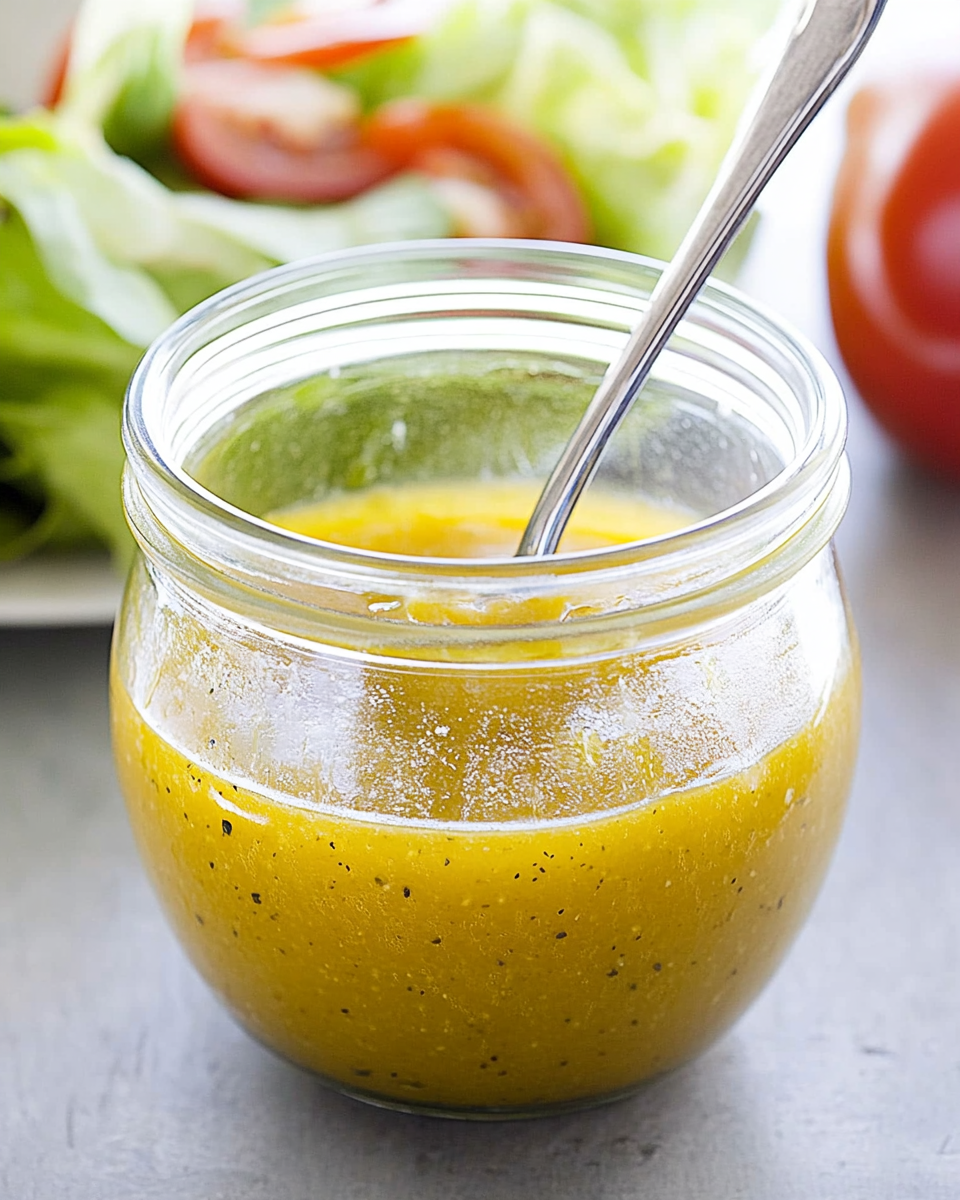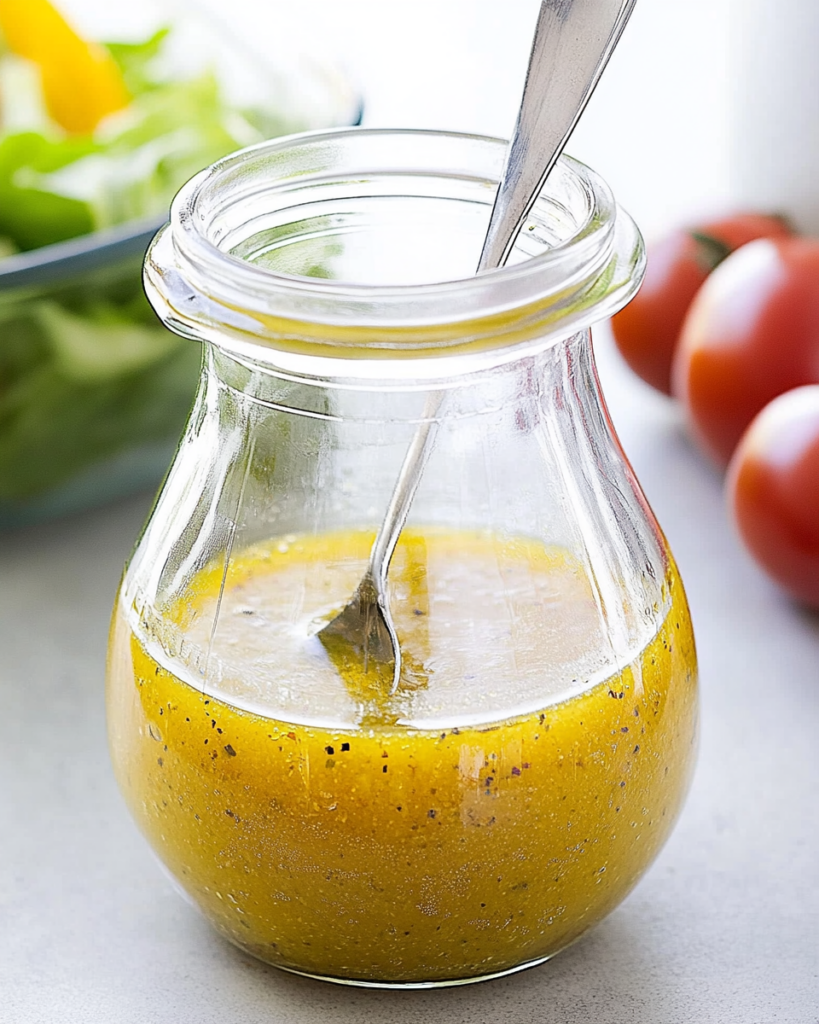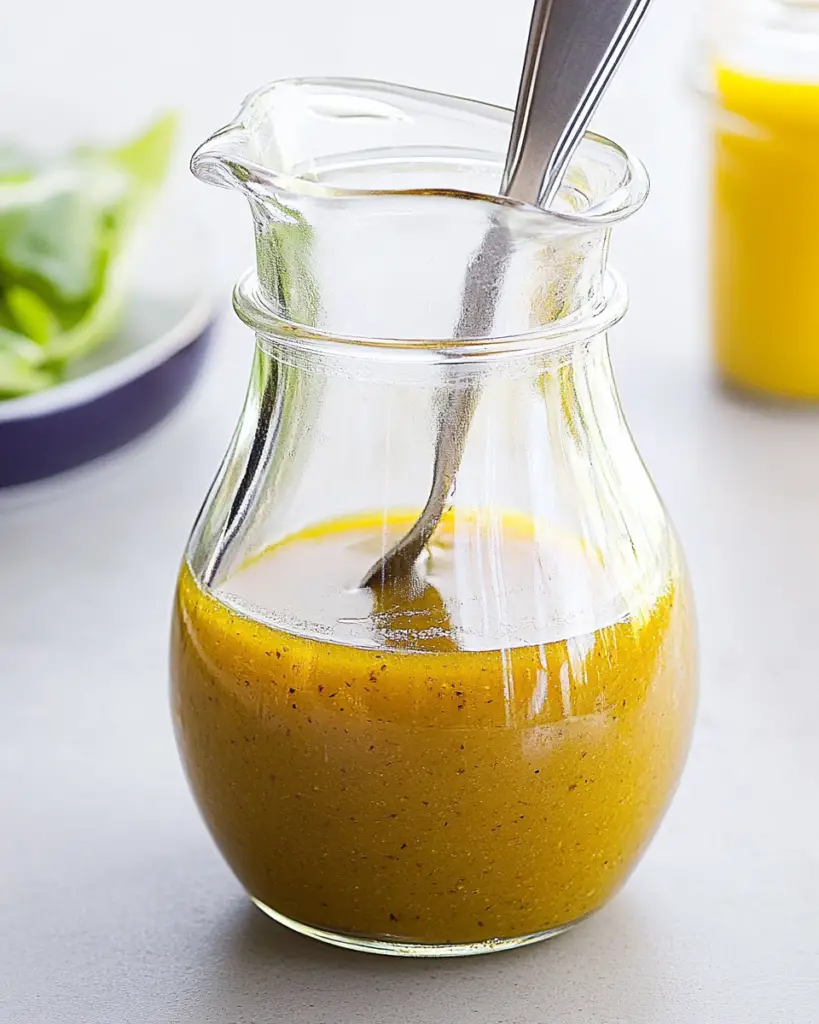A simple vinaigrette is one of the most essential recipes every home cook should have in their repertoire. Light, tangy, and incredibly versatile, this dressing can be made in minutes using pantry staples. Unlike many store-bought versions, this homemade vinaigrette is free from preservatives and added sugars, delivering clean flavor and better nutrition.
What makes this recipe stand out is its adaptability. Whether you’re dressing leafy greens, roasted vegetables, or using it as a quick marinade for proteins, this basic vinaigrette offers the perfect balance of acid and oil. It’s a healthy alternative to creamy or processed dressings, and it lets you take full control over the flavor.

Why You’ll Love This Simple Vinaigrette
This vinaigrette isn’t just easy to make—it’s packed with reasons to love it:
- Ready in under 5 minutes
- Uses simple, wholesome ingredients
- Easily customizable with different vinegars or sweeteners
- Works for salads, grain bowls, roasted vegetables, or marinades
If you’re looking for a dependable, homemade salad dressing that fits into almost any dietary lifestyle, this one’s for you.
Preparation Phase & Tools to Use
This simple vinaigrette requires no cooking. All you need is a container and a few ingredients.
Tools You’ll Need
- A mason jar with a lid or a small mixing bowl
- A whisk or fork (if not shaking in a jar)
- Measuring spoons and cups
Importance of Each Tool
- Mason jar: Great for making, storing, and shaking all in one.
- Whisk: Helps emulsify oil and vinegar for a smooth finish.
- Measuring tools: Ensures precise balance of flavors.
If you don’t have a jar, a bowl and whisk work just as well. You can even use a blender for larger batches.
Preparation Tips
- Room temperature ingredients mix more easily and create a smoother emulsion.
- Use quality olive oil for the best flavor—extra virgin is ideal.
- Balance your flavors by tasting and adjusting as you go.
- Dijon mustard or honey acts as a natural emulsifier to prevent separation.
Ingredients
Here’s everything you need to make this easy vinaigrette:
- ¼ cup extra virgin olive oil
- 2 tablespoons apple cider vinegar
(or substitute white wine, balsamic, or red wine vinegar) - 1½ teaspoons honey
(or use pure maple syrup for a vegan option) - ½ teaspoon Dijon mustard
- ⅛ teaspoon kosher salt
(or fine sea salt) - Black pepper to taste
These ingredients strike a perfect balance of acidity, sweetness, and seasoning.
Step-by-Step Instructions
Follow these simple directions to make your vinaigrette:
- Combine ingredients in a jar with a tight-fitting lid or in a small mixing bowl.
- Shake or whisk vigorously until fully emulsified. The mixture should look smooth and slightly thick.
- Taste and adjust:
- Add more vinegar for extra tang.
- Add more honey for sweetness.
- Adjust salt and pepper to your liking.
- Use immediately, or store in the refrigerator for up to 2 weeks in an airtight container.
Tip:
If your vinaigrette separates or solidifies in the fridge, let it sit at room temperature for a few minutes. Then shake or whisk it again to recombine.
Flavor Variations
One of the best things about a simple vinaigrette is how customizable it is:
- Lemon vinaigrette: Replace vinegar with fresh lemon juice.
- Herb vinaigrette: Add minced garlic, shallots, or fresh herbs like basil or thyme.
- Balsamic vinaigrette: Use balsamic vinegar for a deeper, sweeter flavor.
- Spicy vinaigrette: Add a pinch of red pepper flakes or a dash of hot sauce.
- Maple Dijon: Swap honey for maple syrup and boost the Dijon slightly.
Each variation adds a new dimension while maintaining the core simplicity of the recipe.
Serving Suggestions
A simple vinaigrette is far more than just a salad dressing. Its clean, balanced flavor and quick preparation make it incredibly versatile. Whether you’re elevating your everyday greens or adding a touch of brightness to a cooked dish, this dressing adapts to your needs with ease.
Great Ways to Use Simple Vinaigrette
- Leafy Salads: Drizzle over mixed greens, arugula, spinach, or romaine for a quick and healthy salad.
- Grain Bowls: Mix into quinoa, couscous, or bulgur bowls to add tang and richness.
- Roasted Vegetables: Toss with roasted carrots, sweet potatoes, or Brussels sprouts.
- Marinade: Use as a quick marinade for chicken, tofu, or shrimp.
- Sandwiches and Wraps: Add a splash to sandwiches or grain wraps for moisture and zest.
- Pasta Salad: Lighten up your cold pasta salad with this vinegar-based dressing.
Its flexibility makes this homemade vinaigrette a go-to recipe for busy weeknights or elevated dinners.

Common Mistakes to Avoid
While making a basic vinaigrette is simple, a few mistakes can affect the flavor and texture. Here are the most common issues and how to avoid them.
1. Using Low-Quality Oil
The flavor of a vinaigrette largely depends on the oil. Extra virgin olive oil offers richness and depth. Lower-quality or old oil can taste bitter or rancid. Always use fresh, high-quality oil.
2. Ignoring the Oil-to-Vinegar Ratio
A typical vinaigrette uses a 3:1 ratio of oil to vinegar. Too much vinegar results in harsh acidity, while too much oil can make the dressing bland. Adjust to taste but start with a balanced base.
3. Skipping Emulsifiers
Ingredients like Dijon mustard and honey act as natural emulsifiers. They help keep the oil and vinegar from separating. Skipping them can lead to a watery dressing that doesn’t cling to food.
4. Not Tasting Before Serving
Always taste your vinaigrette before using. Slight adjustments—more acid, sweetness, or salt—can make a big difference.
How to Perfect Your Vinaigrette
A perfect vinaigrette is all about balance and texture. These tips help fine-tune your dressing to suit your dishes and preferences.
1. Taste With the Salad
Instead of tasting on its own, try a spoonful of the vinaigrette on a leaf of your chosen greens. This shows how the flavors work in context, helping you adjust more accurately.
2. Emulsify Properly
For a silky texture, shake or whisk vigorously until the mixture looks slightly thick and uniform. A blender or immersion blender works for larger batches.
3. Customize With Extras
Try these add-ins to take your vinaigrette to the next level:
- Minced garlic or shallots
- Fresh herbs like parsley, thyme, or oregano
- Citrus zest for brightness
- Cracked black pepper or chili flakes for spice
4. Let It Sit Briefly
Letting the dressing sit for a few minutes before serving allows the flavors to meld. This makes for a more cohesive taste.
Side Dish Recommendations
Pairing the right sides with your simple vinaigrette can create a balanced, satisfying meal. Below are eight excellent options that complement the dressing’s tangy profile.
1. Quinoa Salad With Veggies
A cold quinoa salad with cucumbers, tomatoes, and herbs makes a perfect partner for vinaigrette. The grains absorb the dressing well, making every bite flavorful.
2. Roasted Brussels Sprouts
Drizzle warm sprouts with vinaigrette right after roasting. The acid balances the natural bitterness, adding complexity.
3. Couscous With Herbs
Pearl or Moroccan couscous tossed with fresh herbs and vinaigrette creates a light, refreshing side dish.
4. Grilled Asparagus
Brush grilled asparagus with vinaigrette for a tangy, smoky finish.
5. Chopped Kale Salad
Massage kale with vinaigrette to soften the leaves and enhance flavor. Add nuts and dried fruit for texture.
6. Chickpea Salad
Toss chickpeas with diced bell peppers, onion, and vinaigrette for a protein-rich, plant-based side.
7. Roasted Sweet Potatoes
Use vinaigrette as a drizzle for roasted sweet potatoes. The acidity balances their natural sweetness.
8. Tomato Basil Salad
Fresh tomatoes, basil, and vinaigrette are a summer classic. Add mozzarella for a Caprese twist.
These side dishes allow the vinaigrette to shine in different ways, showing off its range and depth.

Recipe Tips and Tricks
A well-made simple vinaigrette can elevate any dish. These expert tips will help you refine your technique and get the most out of every batch.
1. Use Room Temperature Ingredients
Cold oil can solidify when mixed with vinegar, especially if stored in the fridge. Use ingredients at room temperature to ensure proper emulsification and a smoother blend.
2. Add Ingredients in the Right Order
For best results, mix the acid (vinegar or lemon juice), mustard, sweetener, and seasoning first. Then slowly add the oil while whisking or shaking. This encourages the dressing to emulsify rather than separate.
3. Choose the Right Vinegar
Different vinegars provide different flavor profiles:
- Apple cider vinegar is fruity and mellow.
- Red wine vinegar is bold and acidic.
- White wine vinegar is lighter and more delicate.
- Balsamic vinegar is sweet and rich.
Tailor the vinegar to the meal or your taste preferences.
4. Don’t Skip the Emulsifier
Mustard and honey are key for helping the oil and vinegar stay combined. Even a small amount makes a noticeable difference in texture.
5. Use Fresh Ground Pepper and Sea Salt
Freshly ground black pepper adds a bright bite, while high-quality sea salt or kosher salt enhances the overall flavor of the vinaigrette.
Storage and Reheating Instructions
A major benefit of this basic vinaigrette is that it stores beautifully.
How to Store
- Transfer vinaigrette to an airtight container or jar with a lid.
- Keep in the refrigerator for up to 2 weeks.
- Label the jar with the date for easy tracking.
Recombining After Storage
Since this vinaigrette contains oil, it may separate or even solidify in the fridge. Here’s how to fix that:
- Let it sit at room temperature for 10–15 minutes.
- Shake vigorously or whisk until smooth and combined.
Do not microwave to reheat. Gentle warming at room temperature preserves flavor and texture.

Frequently Asked Questions (FAQs)
What is the best oil to use for vinaigrette?
Extra virgin olive oil is the most common choice for its rich flavor and nutritional value. You can also use avocado oil, grapeseed oil, or walnut oil for unique twists.
Can I use lemon juice instead of vinegar?
Yes, fresh lemon juice can replace vinegar to create a citrus-forward vinaigrette. It pairs especially well with herbs and lighter salads.
How long does homemade vinaigrette last?
Stored in an airtight container in the refrigerator, homemade vinaigrette lasts up to two weeks. Shake or stir before each use.
Why does my vinaigrette separate?
Separation occurs naturally when oil and vinegar are left undisturbed. Using emulsifiers like mustard or honey helps keep the dressing together longer.
Is vinaigrette healthier than creamy dressings?
Generally, yes. A simple vinaigrette made with olive oil, vinegar, and natural sweeteners is lower in saturated fat and calories than most creamy dressings.
Can I make vinaigrette without mustard?
You can omit mustard, but the texture may be thinner and the dressing may separate more quickly. Consider using another emulsifier like Greek yogurt or miso for a different effect.
What’s the difference between vinaigrette and salad dressing?
Vinaigrette is a type of salad dressing made from oil and vinegar. It’s lighter and often more acidic. Creamy dressings, like ranch or Caesar, use dairy or mayo as a base.
Can I freeze vinaigrette?
Freezing is not recommended. The oil may separate and the texture will suffer. It’s best made fresh or stored in the refrigerator short term.
Conclusion
This simple vinaigrette is more than just a salad dressing—it’s a foundational recipe every home cook should master. With just a few ingredients and five minutes of prep, you get a healthy, flavorful dressing that can transform everyday meals. Whether used on greens, grains, vegetables, or proteins, its versatility makes it an essential in any kitchen.
Unlike store-bought versions, this homemade vinaigrette offers clean, fresh flavor without additives. It’s easy to tweak based on your preferences, allowing you to explore different vinegars, oils, and add-ins for endless variations.
Try it once, and you’ll see why this dressing belongs in your weekly rotation. Keep a jar in your fridge, and you’ll always have a vibrant, homemade touch ready to elevate your meals.
Simple Vinaigrette
Ingredients
- ¼ cup extra virgin olive oil
- 2 tablespoons apple cider vinegar or white wine vinegar, balsamic vinegar, or red wine vinegar
- 1 ½ teaspoons honey or pure maple syrup
- ½ teaspoon Dijon mustard
- ⅛ teaspoon kosher salt or fine sea salt
- Black pepper to taste
Instructions
- Combine all ingredients in a jar with a tight-fitting lid or in a small mixing bowl.
- If using a jar, seal and shake vigorously until the vinaigrette is well combined. If using a bowl, whisk until fully blended.
- Taste and adjust as needed—add more vinegar or oil to balance acidity and sweetness to your preference.
- Use immediately, or store in the refrigerator in an airtight container for up to 2 weeks.






Leave a Comment